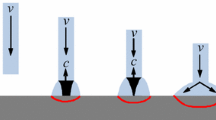Abstract
The numerical simulation method to study rock breaking process and mechanism under high pressure water jet was developed with the continuous mechanics and the FEM theory. The rock damage model and the damage-coupling model suited to analyze the whole process of water jet breaking rock were established with continuum damage mechanics and micro damage mechanics. The numerical results show the dynamic response of rock under water jet and the evolvement of hydrodynamic characteristic of jet during rock breaking is close to reality, and indicates that the body of rock damage and breakage under the general continual jet occurs within several milliseconds, the main damage form is tensile damage caused by rock unload and jet impact, and the evolvement of rock damage shows a step-change trend. On the whole, the numerical results can agree with experimental conclusions, which manifest that the analytical method is feasible and can be applied to guide the research and application of jet breaking rock theory.
Similar content being viewed by others
References
Wang Ruihe, Ni Hongjian. Research of rock fragmentation mechanism with high-pressure water jet [J]. Journal of the University of Petroleum, China (Edition of Natural Science), 2002, 26(4):118–122 (in Chinese).
Zhang Benzhao. The Finite Element Method in Hydromechanics[M]. Mechanical Industrial Press, Beijing, 1986 (in Chinese).
Wang Xucheng, Shao Min. Basic Principle and Numerical Method of Finite Element[M]. Tsinghua University Press, Beijing, 1997 (in Chinese).
Wang Xiaojun. Finite element method and its application in the collision with high speed[J]. Explosion and Shock Wave, 1993, 12(1), 296–304 (in Chinese).
Yun Shourong. Calculation Method of Explosion Mechanics[M]. Beijing Institute of technology Press, Beijing, 1995 (in Chinese).
Chen Tinggen, Guan Zhichuan. Theory and Technology in Drilling Engineering [M]. Petroleum University Press, Shandong, 6–41 (in Chinese).
Furlong J R, Davis J F, Alme M L. Model the Dynamic Load/Unload Behavior of Ceramics Under Impact Loading[R]. RDA-TR-00.0-0001, Arlington, V A: R&D Associates, Arlington, 1990.
Yang Jun, Jin Qiankun, Huang Fenglei. Rock Blasting Theoretical Model and Numerical Simu-lation[M]. Scientific Press, Beijing, 1999 (in Chinese).
Yu Shouwen, Feng Xiqiao. Damage Mechanics[M]. Tsinghua University Press, Beijing, 1997 (in Chinese).
Lemaitre J. Damage Mechanics Course [M]. Tao Chunhu,Ni Jingang (transls). Scientific Press, Beijing, 1996 (Chinese version).
Xu Xiaohe, Yu Jing. Rock Breakage Theory [M]. Coal Industrial Press, Beijing, 1984 (in Chinese).
Author information
Authors and Affiliations
Corresponding author
Additional information
Communicated by LONG Yu-qiu
Project supported by the National Natural Science Foundation of China (Nos. 50574062 and 50234030); the Post-Doctoral Science Foundation of China (No.2004035692)
Rights and permissions
About this article
Cite this article
Ni, Hj., Wang, Rh. & Zhang, Yq. Numerical simulation study on rock breaking mechanism and process under high pressure water jet. Appl. Math. Mech.-Engl. Ed. 26, 1595–1604 (2005). https://doi.org/10.1007/BF03246268
Received:
Revised:
Issue Date:
DOI: https://doi.org/10.1007/BF03246268




